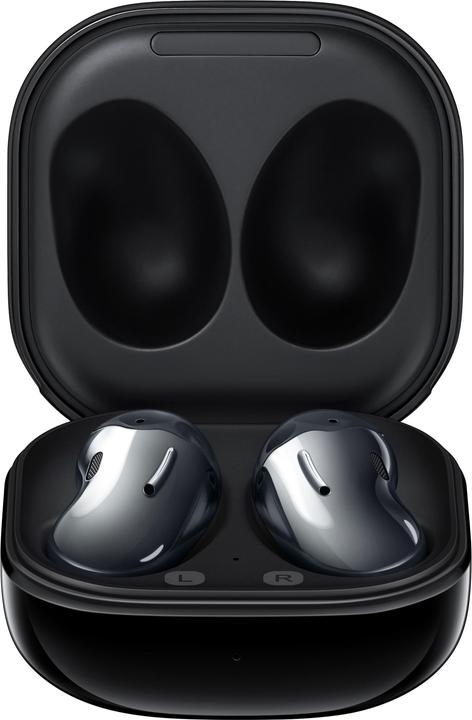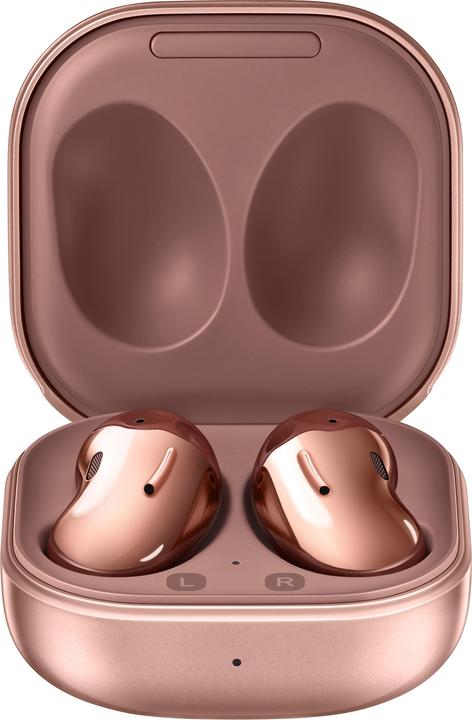
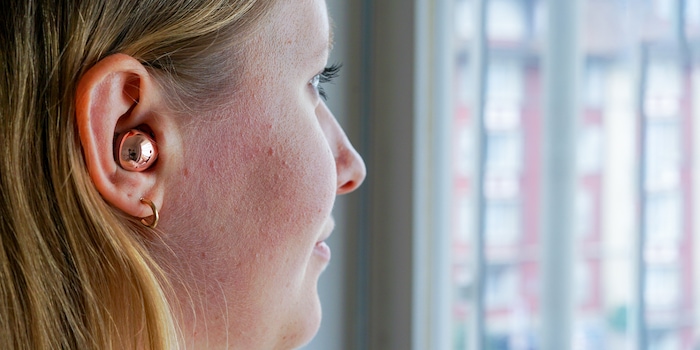
Swapping antennae for beans: Samsung Buds Live review
Samsung is giving us a hot new take on earphones. Although I reckon they should have called them Bean Buds rather than Buds Live. Read on to find out why they didn't pass their test with flying colours.
More and more manufacturers are releasing new true-wireless headphones. But Samsung is doing it slightly differently to the others by unveiling earphones in a new shape. In this case, the buds are shaped like beans. And they've christened them Samsung Galaxy Buds Live. After testing them for a month, I'm here to share the results.
The bean-phones are larger than I imagined. They're also so shiny that you can see your face reflected back at you. The downside of that is they're incredibly slippery. In fact, I'm surprised I didn't lose one of the beans while testing them out.
They fit in my ears well but the seal isn't great
Unlike normal in-ear headphones, the Buds Live are designed to be screwed into your ear. Samsung shows you how to do this in the instructions. But it sounds better than it actually is. You just put each bean quite far into your ear canal and then turn it.
I personally find the Buds comfortable. But to be honest, I'm not exactly fussy when it comes to in-ear headphones, and I've never had any of them give me ear pain. Conversely, one of my colleagues who also bought the Buds Live was chewing my ear off, telling me how the Buds had hurt his ears. So it's really an individual thing as to whether they suit your ears or not.
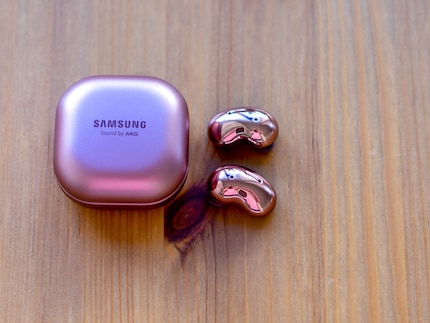
Compared with other in-ear headphones, the Buds can't be adapted that much in terms of fit. Samsung has attached rubber bits to the back, but they're intended more for keeping the outer portion of the Buds in place and are relatively hard. You can't adjust or customise any of the section that sits in your actual ear canal. It either fits or it doesn't. And it's not like you can return or exchange the earphones either, as they're classed as hygiene products.
Having said all of that, there are advantages to the Buds going that far into your ear. For one thing, it doesn't look like you've got antennae sprouting out of your ear while you listen to music. Which is why you can easily wear these in-ear headphones when you've got on a cap, hat or helmet.

Given they sit so far inside your ear, I was convinced they'd seal really well and give excellent passive noise cancellation as a result. After having the Buds in for a minute, I knew better. The Buds are open, so you don't get passive noise reduction.
It reminds me of Huawei's Freebuds. The same mistake was made there. It's just a shame Samsung didn't learn from Huawei.
Hardly any ANC
If the passive seal isn't good, the headphones need to have active noise cancellation (ANC). Unfortunately, you won’t find that on Buds Live either. The beans only manage to filter the lower frequencies a bit. That means you won't hear the sound of the train wheels moving quite as much. But that's the extent of their cancelling capabilities. All the other sounds filter in and get mixed with the music. I haven't even tried to listen to a podcast on the train yet.
So in terms of active noise cancellation, the Buds are in no way comparable with Sony's WF-1000XM3 headphones or the Airpods Pro. Although the latter are small, they can still actively reduce a certain amount of noise.
But Samsung has copied one of Apple's old psychoacoustic tricks and built it into the Buds: when you turn on noise cancellation, you hear an activation sound. As this sound is loud, and it's quiet afterwards by comparison, you get the feeling noise cancellation is at play. But that's not the case.
Given that the buds don't have much of a seal, they seemed like a good cycling companion. After all, they fit under your helmet. I thought the Buds would still let me hear all the sounds around me so I don't suddenly get run over by a tram from behind. But once again, disappointment ensues and I quickly abandon this use case. The reason is if you move faster than a walking pace, the sound of the wind drowns out almost everything else. That means I can hear neither my music nor the traffic. And this happens whether I have noise cancellation activated or not.
The sound could be better
The Buds are cheaper than other true wireless headphones, so I scale back my expectations for the sound right from the very beginning. But even with lowered expectations, I still don't like the sound. I don't find the treble distinct enough. It sounds as though the Buds are smothering it. The mid-range is also lacking for my taste. The vocals, piano and guitar don't come into their own enough. The bass is strong, but it sounds fake and tinny to me.
In terms of sound, the Buds Live are on a par with Huawei Freebuds 3, in my opinion. The quality of the Buds doesn't come close to the level you get from more expensive headphones, such as the Libratone Track Air+.
However, one advantage of the Buds is I never hear my steps when I'm walking or jogging.

Fickle controls
What I find annoying about using the Buds while walking or jogging is the controls. They do what they're supposed to sometimes, but not all the time. For instance, if you tap them too hard, the Buds will skip seven songs all on their own, go back to the start or switch the music off completely. Similarly, I only managed to get the Buds to jump one song ahead when I tapped them about half of the time across the whole testing period.
Even when you hardly touch the Buds, they start following commands. That means the beans will probably also do something as soon as you put them in your ears. Taking them out and putting them back in their case also accidentally activates some kind of command.

Maybe the controls are this jumpy because there are so many command options for the Buds in the app. For instance, you can set them up so that you control the volume on the buds themselves. To do that, you have to hold down your finger on the Bud for a long while. But if you don't hold it down for as long as Samsung wants you to, the volume won't change. Instead, the music will just stop.
Phone audio quality, connection and app: tick, tick, tick
Contrary to expectations, the phone audio quality on the Buds is good. Even when I've got a mask on and am talking from a busy train, my friend can still hear me well. And I can hear her well too. Neither of us had any interruptions or sound interference on the call. The little microphone seems to work well despite the fact the bean is so far inside the ear.
The Buds’ connection to the phone via Bluetooth 5.0 LE was also stable. It was only when passing underneath tram lines that the music sometimes faltered and, in some cases, I lost the connection altogether. But I didn't have this problem in the tram itself, and on the train, the connection was stable as well.
As soon as you open the Buds Live lid, the beans always pair quickly with your phone. Unfortunately, it only uses Bluetooth codecs AAC and the standard codec SBC. Samsung doesn't include AptX codecs for Android phones – only the AAC codec for iOS devices. While most new Android phones can easily be switched to AAC, I still find it annoying that Samsung hasn't included the codec for Android. More and more manufacturers who are targeting an Android audience aren't delivering any AptX codex. It's a frustrating cost-cutting measure.
To add to this, the Buds Live don't support multipoint. To be fair, not many true wireless headphones let you connect to several devices at once, but it would still be nice if you didn't always have to switch the connection manually whenever you want to listen to something on your laptop. But they slightly make up for it with the option to use each earphone individually. The other Bud has to stay in the case, though, otherwise it'll keep turning itself on. And besides, you'd probably just lose it.
As with all the Samsung wearables, the Buds are compatible with the Galaxy Wear app. Before you get started with the app, you have to download the plugin for the Buds Live separately. There's also an iOS version of the app.
It features an equaliser with six presets. They might look nice but they don't do much to help me get the sound I want from the Buds. What is handy is the fact you can get the Buds to beep if you can't find them. Unfortunately, that's only possible when they're in Bluetooth range. You can also use the app to assign the controls or switch them off entirely.
Battery and wireless charging
Samsung says the Buds Live have a battery life of 6 hours. That sounds about right according to my tests, even with noise cancellation activated. But what I find annoying is that one Bud often runs out of battery before the other. The uneven charging means that one Bud disconnects while the other still has 20% battery left. However, the case does store a lot of battery. In fact, it gives you three whole charges for empty Buds.
What bothered me a bit was that the Buds sometimes don't disconnect themselves if you forget to put them back in their case. Then when you come to use them again, the battery has usually run out. That's what's so practical about being able to charge the Buds up wirelessly.
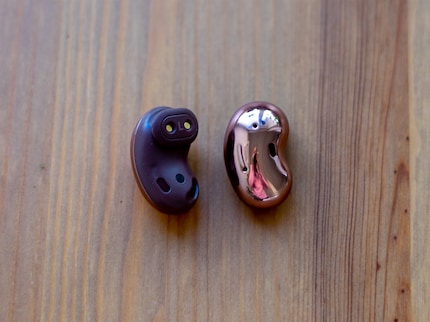
Verdict: they're OK but don't expect too much
Samsung has undeniably revolutionised the shape of earphones with the launch of the Buds. I like this kind of innovation. And the shape has a lot of advantages. It stops the earphones sticking out of your ears and lets them sit further inside your ear comfortably. But I still don't think they're a complete success. The bad sound, annoying controls and poor active and passive noise cancellation rain on the parade that is Samsung's earphone shape revolution.
I don't understand why Samsung didn't learn from the mistakes other manufacturers made and instead launched the headphones as an enclosed design. If Samsung had attached small silicon plugs on the front of the buds, this would have eliminated most of the problems. For one thing, they'd have fit every ear and they'd also have delivered passive noise cancellation.
If I had to buy new earphones today, I'd opt for the Galaxy Buds+. The little silicon plugs make them incredibly comfortable, create a nice seal and get the buds to sit deep inside your ear. To top it all, I much prefer the sound on the Galaxy Buds+.
The Buds Live aren't bad. It's just that you shouldn't expect more from them than their innovative shape.
Testing devices and gadgets is my thing. Some experiments lead to interesting insights, others to demolished phones. I’m hooked on series and can’t imagine life without Netflix. In summer, you’ll find me soaking up the sun by the lake or at a music festival.
These articles might also interest you

Product test
The Samsung Galaxy Buds 2 Pro are worth it – even if you don’t own a Samsung phone
by Livia Gamper

Product test
Trying to fall into a deep sleep, but someone’s snoring? These Soundcore Sleep A30 earbuds can make it happen
by Siri Schubert

Product test
JBL Live 770NC review: affordable over-ear headphones with oodles of options
by Jan Johannsen
